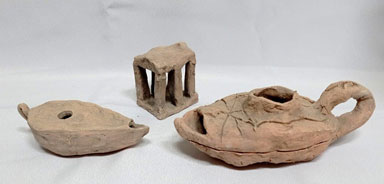The Studio “Living Clay” was created in the Dnipropetrovsk Historical Museum in 1990 at the initiative of Svitlana Ivleva, senior researcher of the Department of Scientific and Educational Work.
The studio program integrates and combines the child’s intellectual, cognitive activity (assimilation of historical and literary material) and his creative development. Such integration is possible to the greatest extent within the walls of the museum. Why the museum? The atmosphere of the museum, the atmosphere of authenticity and antiquity of things of material culture, which children unmistakably feel, forms a mysterious background, activates the imagination. The first part of the class takes place in the exhibition halls, and this allows you to overcome the alienation and formality of the museum exhibition, to make it “talk” to the child, to feel the uniqueness of each time. Thus, on the one hand, the exposure becomes alive for the child, on the other hand, the vividness and imagery of literary sources (legends, tales, fairy tales) acquire a material background and persuasiveness.
In the first part of the lesson, the head of the studio chooses the exhibit(s) to which the story is attached – a replica of Paleolithic Venus, a pin with the head of Thor, a Chumat cart, a Cossack cannon. A story unfolds around the selected exhibit. The complex of exhibits from the Kodak fortress fits very well into the legend of Ivan Sulyma, sculptures of Hermes and Pan begin the cycle of ancient Greek myths, combs and spinning wheels – Ukrainian fairy tales and legends. Each exhibit in the museum can be accompanied not only by historical information, but also by literary sources. It certainly immerses the child in the atmosphere of a certain historical period and stimulates creative imagination. According to the head of the studio, this is precisely the creation of a creative impulse, the desire to reproduce images in clay, and is the most important task of the studio. It should be noted that the path of creative ideas and realizations is very difficult and the child is not always ready to respond to the proposed images right away. She can refer to these images in future classes.
For completely successful studio classes, one more task must be completed – overcoming the feeling of alienation from the modern world during classes. It is very important to give the child the opportunity to feel his original integrity and unity. At the first stage of the lesson, the leader achieves this with the help of literary, mythological material and items from the museum collection. On the second – the child is already trying to do it himself during the creative process – sculpting.
And here I want to say a word in praise of clay. It is this material – clay – that provides unlimited possibilities for the reproduction of historical artifacts. A primitive pot, the head of the Medusa Gorgon, an Egyptian pyramid, an image of a Cossack, a Chumatian cart… any object can be recreated in clay! Thanks to clay, the child is unlimited in his imagination and creativity.
Each museum has great opportunities to influence the creative development of a child. And I, as the head of the studio, am happy that our museum is able to use these opportunities.
Author: S.N.S. S.V. Ivleva


